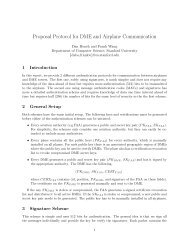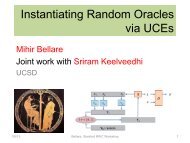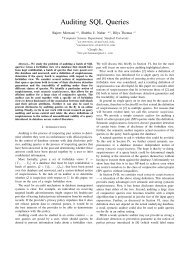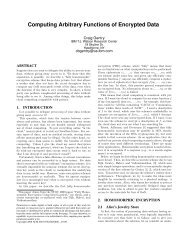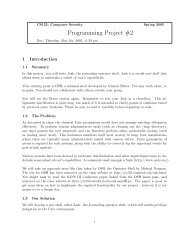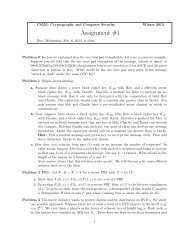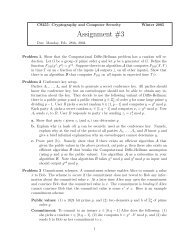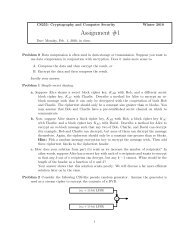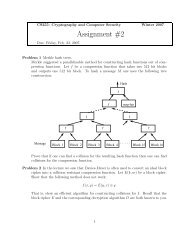PBC Library Manual 0.5.11 - Stanford Crypto Group
PBC Library Manual 0.5.11 - Stanford Crypto Group
PBC Library Manual 0.5.11 - Stanford Crypto Group
You also want an ePaper? Increase the reach of your titles
YUMPU automatically turns print PDFs into web optimized ePapers that Google loves.
<strong>PBC</strong> <strong>Library</strong> <strong>Manual</strong> <strong>0.5.11</strong><br />
Ben Lynn
<strong>PBC</strong> <strong>Library</strong> <strong>Manual</strong> <strong>0.5.11</strong><br />
by Ben Lynn<br />
Revision History<br />
2006 Revised by: BL
Table of Contents<br />
Preface ........................................................................................................................................................v<br />
1. Installing <strong>PBC</strong> ........................................................................................................................................1<br />
1.1. GNU Build System (autotools) ...................................................................................................1<br />
1.2. Simple Makefile ..........................................................................................................................1<br />
1.3. Quick start ...................................................................................................................................1<br />
1.4. Basics ..........................................................................................................................................2<br />
2. Tutorial ...................................................................................................................................................4<br />
2.1. BLS signatures ............................................................................................................................4<br />
2.2. Import/export...............................................................................................................................5<br />
3. Pairing functions....................................................................................................................................8<br />
3.1. Initializing pairings .....................................................................................................................8<br />
3.2. Applying pairings........................................................................................................................9<br />
3.3. Other pairing functions .............................................................................................................10<br />
4. Element functions ................................................................................................................................12<br />
4.1. Initializing elements..................................................................................................................12<br />
4.2. Assigning elements ...................................................................................................................13<br />
4.3. Converting elements..................................................................................................................14<br />
4.4. Element arithmetic ....................................................................................................................14<br />
4.5. Exponentiating elements ...........................................................................................................16<br />
4.6. Comparing elements .................................................................................................................18<br />
4.7. Element I/O ...............................................................................................................................19<br />
4.8. Random elements......................................................................................................................20<br />
4.9. Element import/export ..............................................................................................................21<br />
5. Param functions ...................................................................................................................................24<br />
5.1. Param generation.......................................................................................................................24<br />
6. Other functions ....................................................................................................................................28<br />
6.1. Random bits ..............................................................................................................................28<br />
6.2. Custom allocation .....................................................................................................................29<br />
6.3. Logging .....................................................................................................................................29<br />
7. Bundled programs ...............................................................................................................................31<br />
7.1. Pairing-based calculator............................................................................................................31<br />
7.2. Parameter generation.................................................................................................................32<br />
7.3. Example cryptosystems.............................................................................................................32<br />
7.4. Benchmarks...............................................................................................................................33<br />
8. <strong>PBC</strong> internals .......................................................................................................................................34<br />
8.1. <strong>Group</strong>s, rings, fields ..................................................................................................................34<br />
8.2. Internal randomness ..................................................................................................................36<br />
8.3. Type A internals ........................................................................................................................37<br />
8.4. Type B internals ........................................................................................................................37<br />
8.5. Type C internals ........................................................................................................................38<br />
8.6. Type D internals ........................................................................................................................38<br />
8.7. Type E Internals ........................................................................................................................38<br />
8.8. Type F internals.........................................................................................................................39<br />
iii
8.9. Type G Internals........................................................................................................................40<br />
8.10. Testing functions .....................................................................................................................40<br />
8.11. Dynamic arrays .......................................................................................................................41<br />
8.12. Symbol tables..........................................................................................................................42<br />
8.13. Religious stances.....................................................................................................................43<br />
9. Security issues ......................................................................................................................................45<br />
A. Contributors ........................................................................................................................................46<br />
iv
Preface<br />
The <strong>PBC</strong> library is a free portable C library allowing the rapid prototyping of pairing-based<br />
cryptosystems. It provides an abstract interface to a cyclic group with a bilinear pairing, insulating the<br />
programmer from mathematical details. Knowledge of elliptic curves is optional.<br />
The <strong>PBC</strong> library is built on top of the GMP library, and the <strong>PBC</strong> API is strongly influenced by the GMP<br />
API. Accordingly, this manual tries to imitate the look and feel of the GMP manual.<br />
The <strong>PBC</strong> library homepage: http://crypto.stanford.edu/pbc/<br />
The GMP library homepage: http://www.swox.com/gmp/<br />
v
Chapter 1. Installing <strong>PBC</strong><br />
The <strong>PBC</strong> library needs the GMP library (http://www.swox.com/gmp/). Multiple ways to install <strong>PBC</strong> are<br />
provided.<br />
1.1. GNU Build System (autotools)<br />
This build system has been tested and works on Linux and Mac OS X with a fink installation.<br />
$ ./configure<br />
$ make<br />
$ make install<br />
On Windows, the configure command requires a couple of options:<br />
$ ./configure -disable-static -enable-shared<br />
By default the library is installed in /usr/local/lib. On some systems, this may not be in the library<br />
path. One way to fix this is to edit /etc/ld.so.conf and run ldconfig.<br />
1.2. Simple Makefile<br />
For speed and simplicity, I use simple.make during development. Naturally it is less portable.<br />
$ make -f simple.make<br />
<strong>PBC</strong> uses some GNU C extensions such as nested functions.<br />
1.3. Quick start<br />
We shall use the following notation. For our purposes, the pairing is a bilinear map from two cyclic<br />
groups, G1 and G2 to a third group GT, where each group has prime order r.<br />
Run pbc/pbc and type:<br />
g := rnd(G1);<br />
g;<br />
1
Chapter 1. Installing <strong>PBC</strong><br />
The first line generates a random element g of the group G1, while the second prints out the value of g.<br />
(The syntax was influenced by bc, an arbitrary precision calculator.) Next, enter:<br />
h := rnd(G2);<br />
h;<br />
This assigns h to a random element of the group G2. Actually, the default pairing pbc uses is symmetric<br />
so G1 and G2 are in fact the same group, but in general they are distinct. To compute the pairing applied<br />
to g and h, type:<br />
pairing(g,h);<br />
The order of both g and h is r. Let’s generate two random numbers between 1 and r:<br />
a := rnd(Zr);<br />
b := rnd(Zr);<br />
1.4. Basics<br />
By bilinearity, the resulting output of both of these lines should be identical:<br />
pairing(g^a,h^b);<br />
pairing(g,h)^(a*b);<br />
This program has other features but the commands shown here should be enough to quickly and<br />
interactively experiment with many pairing-based cryptosystems using real numbers.<br />
Programs using the <strong>PBC</strong> library should include the file pbc.h:<br />
#include <br />
and linked against the <strong>PBC</strong> library and the GMP library, e.g.<br />
$ gcc program.c -L. -lpbc -lgmp<br />
The file pbc.h already includes gmp.h.<br />
<strong>PBC</strong> follows GMP in several respects:<br />
• Output arguments generally precede input arguments.<br />
• The same variable can be used as input and output in one call.<br />
• Before a variable may be used it must be initialized exactly once. When no longer needed it must be<br />
cleared. For efficiency, unnecessary initializating and clearing should be avoided.<br />
2
Chapter 1. Installing <strong>PBC</strong><br />
• <strong>PBC</strong> variables ending with _t behave the same as GMP variables in function calls: effectively as<br />
call-by references. In other words, as in GMP, if a function that modifies an input variable, that<br />
variable remains modified when control return is returned to the caller.<br />
• Like GMP, variables automatically allocate memory when needed. By default, malloc() and friends<br />
are called but this can be changed.<br />
• <strong>PBC</strong> functions are mostly reentrant.<br />
Since the <strong>PBC</strong> library is built on top of GMP, the GMP types are available. <strong>PBC</strong> types are similar to<br />
GMP types. The following example is paraphrased from an example in the GMP manual, and shows how<br />
to declare the <strong>PBC</strong> data type element_t.<br />
element_t sum;<br />
struct foo { element_t x, y; };<br />
element_t vec[20];<br />
GMP has the mpz_t type for integers, mpq_t for rationals and so on. In contrast, <strong>PBC</strong> uses the<br />
element_t data type for elements of different algebraic structures, such as elliptic curve groups,<br />
polynomial rings and finite fields. Functions assume their inputs come from appropriate algebraic<br />
structures.<br />
<strong>PBC</strong> data types and functions can be categorized as follows. The first two alone suffice for a range of<br />
applications.<br />
• element_t: elements of an algebraic structure.<br />
• pairing_t: pairings where elements belong; can initialize from sample pairing parameters bundled<br />
with <strong>PBC</strong> in the param subdirectory.<br />
• pbc_param_t: used to generate pairing parameters.<br />
• pbc_cm_t: parameters for constructing curves via the CM method; sometimes required by<br />
pbc_param_t.<br />
• field_t: algebraic structures: groups, rings and fields; used internally by pairing_t.<br />
• a few miscellaneous functions, such as ones controlling how random bits are generated.<br />
Functions operating on a given data type usually have the same prefix, e.g. those involving element_t<br />
objects begin with element_.<br />
3
Chapter 2. Tutorial<br />
This chapter walks through how one might implement the Boneh-Lynn-Shacham (BLS) signature<br />
scheme using the <strong>PBC</strong> library. It is based on the file example/bls.c.<br />
We have three groups G1, G2, GT of prime order r, and a bilinear map e that takes an element from G1<br />
and an element from G2, and outputs an element of GT. We publish these along with the system<br />
parameter g, which is a randomly chosen element of G2.<br />
Alice wishes to sign a message. She generates her public and private keys as follows. Her private key is a<br />
random element x of Zr, and her corresponding public key is g x .<br />
To sign a message, Alice hashes the message to some element h of G1, and then outputs the signature h x .<br />
To verify a signature σ, Bob checks that e(h,g x ) = e(σ, g).<br />
We now translate the above to C code using the <strong>PBC</strong> library.<br />
2.1. BLS signatures<br />
First we include pbc/pbc.h:<br />
#include <br />
Next we initialize a pairing:<br />
pairing_t pairing;<br />
char param[1024];<br />
size_t count = fread(param, 1, 1024, stdin);<br />
if (!count) pbc_die("input error");<br />
pairing_init_set_buf(pairing, param, count);<br />
Later we give pairing parameters to our program on standard input. Any file in the param subdirectory<br />
will suffice, for example:<br />
$ bls < param/a.param<br />
We shall need several element_t variables to hold the system parameters, keys and other quantities. We<br />
declare them and initialize them,<br />
element_t g, h;<br />
element_t public_key, secret_key;<br />
4
element_t sig;<br />
element_t temp1, temp2;<br />
element_init_G2(g, pairing);<br />
element_init_G2(public_key, pairing);<br />
element_init_G1(h, pairing);<br />
element_init_G1(sig, pairing);<br />
element_init_GT(temp1, pairing);<br />
element_init_GT(temp2, pairing);<br />
element_init_Zr(secret_key, pairing);<br />
generate system parameters,<br />
element_random(g);<br />
generate a private key,<br />
element_random(secret_key);<br />
and the corresponding public key.<br />
element_pow_zn(public_key, g, secret_key);<br />
Chapter 2. Tutorial<br />
When given a message to sign, we first compute its hash, using some standard hash algorithm. Many<br />
libraries can do this, and this operation does not involve pairings, so <strong>PBC</strong> does not provide functions for<br />
this step. For this example, and our message has already been hashed, possibly using another library.<br />
Say the message hash is "ABCDEF" (a 48-bit hash). We map these bytes to an element h of G1,<br />
element_from_hash(h, "ABCDEF", 6);<br />
then sign it:<br />
element_pow_zn(sig, h, secret_key);<br />
To verify this signature, we compare the outputs of the pairing applied to the signature and system<br />
parameter, and the pairing applied to the message hash and public key. If the pairing outputs match then<br />
the signature is valid.<br />
pairing_apply(temp1, sig, g, pairing);<br />
pairing_apply(temp2, h, public_key, pairing);<br />
if (!element_cmp(temp1, temp2)) {<br />
printf("signature verifies\n");<br />
} else {<br />
printf("signature does not verify\n");<br />
}<br />
5
2.2. Import/export<br />
Chapter 2. Tutorial<br />
To be useful, at some stage the signature must be converted to bytes for storage or transmission:<br />
int n = pairing_length_in_bytes_compressed_G1(pairing);<br />
// Alternatively:<br />
// int n = element_length_in_bytes_compressed(sig);<br />
unsigned char *data = malloc(n);<br />
element_to_bytes_compressed(data, sig);<br />
On the other end, the signature must be decompressed:<br />
element_from_bytes_compressed(sig, data);<br />
Eliding _compressed in the above code will also work but the buffer data will be roughly twice as large.<br />
We can save more space by using the x-coordinate of the signature only<br />
int n = pairing_length_in_bytes_x_only_G1(pairing);<br />
// Alternative:<br />
// int n = element_length_in_bytes_x_only(sig);<br />
unsigned char *data = malloc(n);<br />
element_to_bytes_compressed(data, sig);<br />
but then there is a complication during verification since two different points have the same x-coordinate.<br />
One way to solve this problem is to guess one point and try to verify. If that fails, we try the other. It can<br />
be shown that the pairing outputs of the two points are inverses of each other, avoiding the need to<br />
compute a pairing the second time. (In fact, there are even better ways to handle this.)<br />
int n = pairing_length_in_bytes_x_only_G1(pairing);<br />
//int n = element_length_in_bytes_x_only(sig);<br />
unsigned char *data = malloc(n);<br />
element_to_bytes_x_only(data, sig);<br />
element_from_bytes_x_only(sig, data)<br />
pairing_apply(temp1, sig, g, pairing);<br />
pairing_apply(temp2, h, public_key, pairing);<br />
if (!element_cmp(temp1, temp2)) {<br />
printf("signature verifies on first guess\n");<br />
} else {<br />
element_invert(temp1, temp1);<br />
if (!element_cmp(temp1, temp2)) {<br />
printf("signature verifies on second guess\n");<br />
} else {<br />
printf("signature does not verify\n");<br />
}<br />
6
}<br />
Chapter 2. Tutorial<br />
7
Chapter 3. Pairing functions<br />
An application should first initialize a pairing object. This causes <strong>PBC</strong> to setup curves, groups and other<br />
mathematical miscellany. After that, elements can be initialized and manipulated for cryptographic<br />
operations.<br />
Parameters for various pairings are included with the <strong>PBC</strong> library distribution in the param subdirectory,<br />
and some are suitable for cryptographic use. Some programs in the gen subdirectory may be used to<br />
generate parameters (see Chapter 7). Also, see the <strong>PBC</strong> website for many more pairing parameters.<br />
Pairings involve three groups of prime order. The <strong>PBC</strong> library calls them G1, G2, and GT, and calls the<br />
order r. The pairing is a bilinear map that takes two elements as input, one from G1 and one from G2,<br />
and outputs an element of GT.<br />
The elements of G2 are at least as long as G1; G1 is guaranteed to be the shorter of the two. Sometimes<br />
G1 and G2 are the same group (i.e. the pairing is symmetric) so their elements can be mixed freely. In<br />
this case the pairing_is_symmetric function returns 1.<br />
Bilinear pairings are stored in the data type pairing_t. Functions that operate on them start with<br />
pairing_.<br />
3.1. Initializing pairings<br />
To initialize a pairing from an ASCIIZ string:<br />
pairing_t pairing;<br />
pairing_init_set_str(pairing, s); // Where s is a char *.<br />
The string s holds pairing parameters in a text format. The param subdirectory contains several<br />
examples.<br />
Alternatively, call:<br />
pairing_t pairing;<br />
pairing_init_pbc_param(pairing, param);<br />
where param is an initialized pbc_param_t (see Chapter 5).<br />
int pairing_init_set_str(pairing_t pairing, const char *s)<br />
8
Initialize pairing from parameters in a ASCIIZ string str Returns 0 on success, 1 on failure.<br />
int pairing_init_set_buf(pairing_t pairing, const char *s, size_t len)<br />
Chapter 3. Pairing functions<br />
Same, but read at most len bytes. If len is 0, it behaves as the previous function. Returns 0 on success, 1 on<br />
failure.<br />
void pairing_init_pbc_param(struct pairing_s *pairing, pbc_param_t p)<br />
Initialize a pairing with pairing parameters p.<br />
void pairing_clear(pairing_t pairing)<br />
Free the space occupied by pairing. Call whenever a pairing_t variable is no longer needed. Only call this<br />
after all elements associated with pairing have been cleared, as they need information stored in the pairing<br />
structure.<br />
3.2. Applying pairings<br />
The function pairing_apply can be called to apply a bilinear map. The order of the inputs is<br />
important. The first, which holds the output, must be from the group GT. The second must be from G1,<br />
the third from G2, and the fourth must be the pairing_t variable that relates them.<br />
In some applications, the programmer may know that many pairings with the same G1 input will be<br />
computed. If so, preprocessing should be used to avoid repeating many calculations saving time in the<br />
long run. A variable of type pairing_pp_t should be declared, initialized with the fixed G1 element,<br />
and then used to compute pairings:<br />
pairing_pp_t pp;<br />
pairing_pp_init(pp, x, pairing); // x is some element of G1<br />
pairing_pp_apply(r1, y1, pp); // r1 = e(x, y1)<br />
pairing_pp_apply(r2, y2, pp); // r2 = e(x, y2)<br />
pairing_pp_clear(pp); // don’t need pp anymore<br />
Never mix and match G1, G2, and GT groups from different pairings.<br />
void pairing_pp_init(pairing_pp_t p, element_t in1, pairing_t pairing)<br />
9
Chapter 3. Pairing functions<br />
Get ready to perform a pairing whose first input is in1, and store the results of time-saving precomputation in p.<br />
void pairing_pp_clear(pairing_pp_t p)<br />
Clear p. This should be called after p is no longer needed.<br />
void pairing_pp_apply(element_t out, element_t in2, pairing_pp_t p)<br />
Compute a pairing using in2 and the preprocessed information stored in p and store the output in out. The<br />
inputs to the pairing are the element previously used to initialize p and the element in2.<br />
void element_pairing(element_t out, element_t in1, element_t in2)<br />
Computes a pairing: out = e(in1, in2), where in1, in2, out must be in the groups G1, G2, GT.<br />
void element_prod_pairing(element_t out, element_t in1[], element_t in2[], int n)<br />
Computes the product of pairings, that is out = e(in1[0], in2[0]) . . . e(in1[n-1], in2[n-1]). The arrays in1, in2<br />
must have at least n elements belonging to the groups G1, G2 respectively, and out must belong to the group<br />
GT.<br />
3.3. Other pairing functions<br />
int pairing_is_symmetric(pairing_t pairing)<br />
Returns true if G1 and G2 are the same group.<br />
int pairing_length_in_bytes_G1(pairing_t pairing)<br />
Returns the length in bytes needed to represent an element of G1.<br />
10
int pairing_length_in_bytes_x_only_G1(pairing_t pairing)<br />
Returns the length in bytes needed to represent the x-coordinate of an element of G1.<br />
int pairing_length_in_bytes_compressed_G1(pairing_t pairing)<br />
Chapter 3. Pairing functions<br />
Returns the length in bytes needed to represent a compressed form of an element of G1. There is some<br />
overhead in decompressing.<br />
int pairing_length_in_bytes_G2(pairing_t pairing)<br />
Returns the length in bytes needed to represent an element of G2.<br />
int pairing_length_in_bytes_compressed_G2(pairing_t pairing)<br />
Returns the length in bytes needed to represent a compressed form of an element of G2. There is some<br />
overhead in decompressing.<br />
int pairing_length_in_bytes_x_only_G2(pairing_t pairing)<br />
Returns the length in bytes needed to represent the x-coordinate of an element of G2.<br />
int pairing_length_in_bytes_GT(pairing_t pairing)<br />
Returns the length in bytes needed to represent an element of GT.<br />
int pairing_length_in_bytes_Zr(pairing_t pairing)<br />
Returns the length in bytes needed to represent an element of Zr.<br />
11
Chapter 4. Element functions<br />
Elements of groups, rings and fields are stored in the element_t data type. Variables of this type must<br />
be initialized before use, and should be cleared after they are no longer needed.<br />
The element_ functions must be used with caution. Just as division by zero does not make sense for<br />
integers, some operations may not make sense for particular elements. For example, in a ring, one cannot<br />
in general invert elements.<br />
Another caveat is that many of these functions assume their arguments come from the same ring, group<br />
or field. No implicit type casting is performed.<br />
For debug builds, turn on run-time checks by defining <strong>PBC</strong>_DEBUG before including pbc.h:<br />
#define <strong>PBC</strong>_DEBUG<br />
#include <br />
Also, when <strong>PBC</strong>_DEBUG is defined, the following macros are active. Normally they are replaced with<br />
empty statements.<br />
<strong>PBC</strong>_ASSERT(expr, msg)<br />
Macro: if expr evaluates to 0, print msg and exit.<br />
<strong>PBC</strong>_ASSERT_MATCH2(a, b)<br />
Macro: if elements a and b are from different fields then exit.<br />
<strong>PBC</strong>_ASSERT_MATCH3(a, b, c)<br />
Macro: if elements a, b and c are from different fields then exit.<br />
12
4.1. Initializing elements<br />
Chapter 4. Element functions<br />
When an element is initialized it is associated with an algebraic structure, such as a particular finite field<br />
or elliptic curve group.<br />
We use G1 and G2 to denote the input groups to the pairing, and GT for the output group. All have order<br />
r, and Zr means the ring of integers modulo r. G1 is the smaller group (the group of points over the base<br />
field). With symmetric pairings, G1 = G2.<br />
void element_init_G1(element_t e, pairing_t pairing)<br />
void element_init_G2(element_t e, pairing_t pairing)<br />
void element_init_GT(element_t e, pairing_t pairing)<br />
Initialize e to be an element of the group G1, G2 or GT of pairing.<br />
void element_init_Zr(element_t e, pairing_t pairing)<br />
Initialize e to be an element of the ring Z_r of pairing. r is the order of the groups G1, G2 and GT that are<br />
involved in the pairing.<br />
void element_init_same_as(element_t e, element_t e2)<br />
Initialize e to be an element of the algebraic structure that e2 lies in.<br />
void element_clear(element_t e)<br />
Free the space occupied by e. Call this when the variable e is no longer needed.<br />
4.2. Assigning elements<br />
These functions assign values to elements. When integers are assigned, they are mapped to algebraic<br />
structures canonically if it makes sense (e.g. rings and fields).<br />
13
void element_set0(element_t e)<br />
Set e to zero.<br />
void element_set1(element_t e)<br />
Set e to one.<br />
void element_set_si(element_t e, signed long int i)<br />
Set e to i.<br />
void element_set_mpz(element_t e, mpz_t z)<br />
Set e to z.<br />
void element_set(element_t e, element_t a)<br />
Set e to a.<br />
4.3. Converting elements<br />
void element_to_mpz(mpz_t z, element_t e)<br />
Converts e to a GMP integer z if such an operation makes sense<br />
void element_from_hash(element_t e, void *data, int len)<br />
Generate an element e deterministically from the len bytes stored in the buffer data.<br />
Chapter 4. Element functions<br />
14
4.4. Element arithmetic<br />
Chapter 4. Element functions<br />
Unless otherwise stated, all element_t arguments to these functions must have been initialized to be<br />
from the same algebraic structure. When one of these functions expects its arguments to be from<br />
particular algebraic structures, this is reflected in the name of the function.<br />
The addition and multiplication functions perform addition and multiplication operations in rings and<br />
fields. For groups of points on an ellitpic curve, such as the G1 and G2 groups associated with pairings,<br />
both addition and multiplication represent the group operation (and similarly both 0 and 1 represent the<br />
identity element). It is recommended that programs choose and one convention and stick with it to avoid<br />
confusion.<br />
In contrast, the GT group is currently implemented as a subgroup of a finite field, so only multiplicative<br />
operations should be used for GT.<br />
void element_add(element_t n, element_t a, element_t b)<br />
Set n to a + b.<br />
void element_sub(element_t n, element_t a, element_t b)<br />
Set n to a - b.<br />
void element_mul(element_t n, element_t a, element_t b)<br />
Set n = a b.<br />
void element_mul_mpz(element_t n, element_t a, mpz_t z)<br />
void element_mul_si(element_t n, element_t a, signed long int z)<br />
Set n = a z, that is a + a + . . . + a where there are z a’s.<br />
void element_mul_zn(element_t c, element_t a, element_t z)<br />
15
Chapter 4. Element functions<br />
z must be an element of a integer mod ring (i.e. Z n for some n). Set c = a z, that is a + a + . . . + a where there<br />
are z a’s.<br />
void element_div(element_t n, element_t a, element_t b)<br />
Set n = a / b.<br />
void element_double(element_t n, element_t a)<br />
Set n = a + a.<br />
void element_halve(element_t n, element_t a)<br />
Set n = a/2<br />
void element_square(element_t n, element_t a)<br />
Set n = a 2<br />
void element_neg(element_t n, element_t a)<br />
Set n = -a.<br />
void element_invert(element_t n, element_t a)<br />
Set n to the inverse of a.<br />
16
4.5. Exponentiating elements<br />
Chapter 4. Element functions<br />
Exponentiation and multiexponentiation functions. If it is known in advance that a particular element<br />
will be exponentiated several times in the future, time can be saved in the long run by first calling the<br />
preprocessing function:<br />
element_pp_t g_pp;<br />
element_pp_init(g_pp, g);<br />
element_pp_pow(h, pow1, g_pp); // h = g^pow1<br />
element_pp_pow(h, pow2, g_pp); // h = g^pow2<br />
element_pp_pow(h, pow3, g_pp); // h = g^pow3<br />
element_pp_clear(g_pp);<br />
void element_pow_mpz(element_t x, element_t a, mpz_t n)<br />
Set x = a n , that is a times a times . . . times a where there are n a’s.<br />
void element_pow_zn(element_t x, element_t a, element_t n)<br />
Set x = a n , where n is an element of a ring Z N for some N (typically the order of the algebraic structure x lies in).<br />
void element_pow2_mpz(element_t x, element_t a1, mpz_t n1, element_t a2, mpz_t n2)<br />
Sets x = a1 n1 a2 n2 , and is generally faster than performing two separate exponentiations.<br />
void element_pow2_zn(element_t x, element_t a1, element_t n1, element_t a2, element_t n2)<br />
Also sets x = a1 n1 a2 n2 , but n1, n2 must be elements of a ring Z n for some integer n.<br />
void element_pow3_mpz(element_t x, element_t a1, mpz_t n1, element_t a2, mpz_t n2, element_t a3,<br />
mpz_t n3)<br />
Sets x = a1 n1 a2 n2 a3 n3 , generally faster than performing three separate exponentiations.<br />
17
Chapter 4. Element functions<br />
void element_pow3_zn(element_t x, element_t a1, element_t n1, element_t a2, element_t n2, element_t<br />
a3, element_t n3)<br />
Also sets x = a1 n1 a2 n2 a3 n3 , but n1, n2, n3 must be elements of a ring Z n for some integer n.<br />
void element_pp_init(element_pp_t p, element_t in)<br />
Prepare to exponentiate an element in, and store preprocessing information in p.<br />
void element_pp_clear(element_pp_t p)<br />
Clear p. Should be called after p is no longer needed.<br />
void element_pp_pow(element_t out, mpz_t power, element_pp_t p)<br />
Raise in to power and store the result in out, where in is a previously preprocessed element, that is, the second<br />
argument passed to a previous element_pp_init call.<br />
void element_pp_pow_zn(element_t out, element_t power, element_pp_t p)<br />
Same except power is an element of Z n for some integer n.<br />
void element_dlog_brute_force(element_t x, element_t g, element_t h)<br />
Computes x such that g x = h by brute force, where x lies in a field where element_set_mpz() makes sense.<br />
void element_dlog_pollard_rho(element_t x, element_t g, element_t h)<br />
Computes x such that g x = h using Pollard rho method, where x lies in a field where element_set_mpz()<br />
makes sense.<br />
18
4.6. Comparing elements<br />
These functions compare elements from the same algebraic structure.<br />
int element_is1(element_t n)<br />
Returns true if n is 1.<br />
int element_is0(element_t n)<br />
Returns true if n is 0.<br />
int element_cmp(element_t a, element_t b)<br />
Returns 0 if a and b are the same, nonzero otherwise.<br />
int element_is_sqr(element_t a)<br />
Returns nonzero if a is a perfect square (quadratic residue), zero otherwise.<br />
int element_sgn(element_t a)<br />
int element_sign(element_t a)<br />
Chapter 4. Element functions<br />
If a is zero, returns 0. For nozero a the behaviour depends on the algebraic structure, but has the property that<br />
element_sgn(a) = -element_sgn(-a) and element_sgn(a) = 0 implies a = 0 with overwhelming probability.<br />
4.7. Element I/O<br />
Functions for producing human-readable outputs for elements. Converting elements to and from bytes<br />
are discussed later.<br />
19
size_t element_out_str(FILE * stream, int base, element_t e)<br />
Output e on stream in base base. The base must be between 2 and 36.<br />
int element_printf(const char *format, . . . )<br />
int element_fprintf(FILE * stream, const char *format, . . . )<br />
int element_snprintf(char *buf , size_t size, const char *fmt, . . . )<br />
int element_vsnprintf(char *buf , size_t size, const char *fmt, va_list ap)<br />
Chapter 4. Element functions<br />
Same as printf family except also has the B conversion specifier for types of element_t, and Y, Z conversion<br />
specifiers for mpz_t. For example if e is of type element_t then<br />
element_printf("%B\n", e);<br />
will print the value of e in a human-readable form on standard output.<br />
int element_snprint(char *s, size_t n, element_t e)<br />
Convert an element to a human-friendly string. Behaves as snprintf but only on one element at a time.<br />
int element_set_str(element_t e, const char *s, int base)<br />
Set the element e from s, a null-terminated C string in base base. Whitespace is ignored. Points have the form<br />
"[x,y]" or "O", while polynomials have the form "[a0,. . . ,an]". Returns number of characters read (unlike<br />
GMP’s mpz_set_str). A return code of zero means <strong>PBC</strong> could not find a well-formed string describing an<br />
element.<br />
4.8. Random elements<br />
Only works for finite algebraic structures. Effect on polynomial rings, fields of characteristic zero, etc.<br />
undefined.<br />
20
See Section 6.1 for how <strong>PBC</strong> gets random bits.<br />
void element_random(element_t e)<br />
If the e lies in a finite algebraic structure, assigns a uniformly random element to e.<br />
4.9. Element import/export<br />
Functions for serializing and deserializing elements.<br />
int element_length_in_bytes(element_t e)<br />
Returns the length in bytes the element e will take to represent<br />
int element_to_bytes(unsigned char *data, element_t e)<br />
Chapter 4. Element functions<br />
Converts e to byte, writing the result in the buffer data. The number of bytes it will write can be determined<br />
from calling element_length_in_bytes(). Returns number of bytes written.<br />
int element_from_bytes(element_t e, unsigned char *data)<br />
Reads e from the buffer data, and returns the number of bytes read.<br />
int element_to_bytes_x_only(unsigned char *data, element_t e)<br />
Assumes e is a point on an elliptic curve. Writes the x-coordinate of e to the buffer data<br />
int element_from_bytes_x_only(element_t e, unsigned char *data)<br />
Assumes e is a point on an elliptic curve. Sets e to a point with x-coordinate represented by the buffer data.<br />
This is not unique. For each x-coordinate, there exist two different points, at least for the elliptic curves in <strong>PBC</strong>.<br />
(They are inverses of each other.)<br />
21
int element_length_in_bytes_x_only(element_t e)<br />
Chapter 4. Element functions<br />
Assumes e is a point on an elliptic curve. Returns the length in bytes needed to hold the x-coordinate of e.<br />
int element_to_bytes_compressed(unsigned char *data, element_t e)<br />
If possible, outputs a compressed form of the element e to the buffer of bytes data. Currently only implemented<br />
for points on an elliptic curve.<br />
int element_from_bytes_compressed(element_t e, unsigned char *data)<br />
Sets element e to the element in compressed form in the buffer of bytes data. Currently only implemented for<br />
points on an elliptic curve.<br />
int element_length_in_bytes_compressed(element_t e)<br />
Returns the number of bytes needed to hold e in compressed form. Currently only implemented for points on<br />
an elliptic curve.<br />
int element_item_count(element_t e)<br />
For points, returns the number of coordinates. For polynomials, returns the number of coefficients. Otherwise<br />
returns zero.<br />
element_t element_item(element_t e, int i)<br />
For points, returns nth coordinate. For polynomials, returns coefficient of x n . Otherwise returns NULL. The<br />
element the return value points to may be modified.<br />
element_t element_x(element_t a)<br />
22
Equivalent to element_item(a, 0).<br />
element_t element_y(element_t a)<br />
Equivalent to element_item(a, 1).<br />
Chapter 4. Element functions<br />
23
Chapter 5. Param functions<br />
Pairings are initialized from pairing parameters, which are objects of type pbc_param_t. Some<br />
applications can ignore this data type because pairing_init_set_str() handles it behind the scenes:<br />
it reads a string as a pbc_param_t, then initializes a pairing with these parameters.<br />
int pbc_param_init_set_str(pbc_param_t par, const char *s)<br />
Initializes pairing parameters from the string s. Returns 0 if successful, 1 otherwise.<br />
int pbc_param_init_set_buf(pbc_param_t par, const char *s, size_t len)<br />
Same, but read at most len bytes. If len is 0, it behaves as the previous function. Returns 0 if successful, 1<br />
otherwise.<br />
void pbc_param_out_str(FILE *stream, pbc_param_t p)<br />
Write pairing parameters to ’stream’ in a text format.<br />
void pbc_param_clear(pbc_param_t p)<br />
Clear p. Call after p is no longer needed.<br />
5.1. Param generation<br />
These were used to prepare the sample parameters in the param subdirectory.<br />
We label the pairing families with capital letters roughly in the order of discovery, so we can refer to<br />
them easily. Type A is fastest. Type D is a good choice when elements should be short but is slower. Type<br />
F has even shorter elements but is slower still. The speed differences are hardware-dependent, and also<br />
change when preprocessing is used. Type B and C are unimplemented.<br />
The pbc_cm_t data type holds CM parameters that are used to generate type D and G curves.<br />
24
void pbc_cm_init(pbc_cm_t cm)<br />
Initializes cm.<br />
void pbc_cm_clear(pbc_cm_t cm)<br />
Clears cm.<br />
Chapter 5. Param functions<br />
int pbc_cm_search_d(int (*callback)(pbc_cm_t, void *), void *data, unsigned int D, unsigned int<br />
bitlimit)<br />
For a given discriminant D, searches for type D pairings suitable for cryptography (MNT curves of embedding<br />
degree 6). The group order is at most bitlimit bits. For each set of CM parameters found, call callback with<br />
pbc_cm_t and given void *. If the callback returns nonzero, stops search and returns that value. Otherwise<br />
returns 0.<br />
int pbc_cm_search_g(int (*callback)(pbc_cm_t, void *), void *data, unsigned int D, unsigned int<br />
bitlimit)<br />
For a given discriminant D, searches for type G pairings suitable for cryptography (Freeman curve). The group<br />
order is at most bitlimit bits. For each set of CM parameters found, call callback with pbc_cm_t and given<br />
void *. If the callback returns nonzero, stops search and returns that value. Otherwise returns 0.<br />
void pbc_param_init_a_gen(pbc_param_t par, int rbits, int qbits)<br />
Generate type A pairing parameters and store them in p, where the group order r is rbits long, and the order of<br />
the base field q is qbits long. Elements take qbits to represent.<br />
To be secure, generic discrete log algorithms must be infeasible in groups of order r, and finite field discrete log<br />
algorithms must be infeasible in finite fields of order q^2, e.g. rbits = 160, qbits = 512.<br />
The file param/a.param contains parameters for a type A pairing suitable for cryptographic use.<br />
void pbc_param_init_a1_gen(pbc_param_t param, mpz_t n)<br />
25
Chapter 5. Param functions<br />
Generate type A1 pairing parameters and store them in p. The group order will be n. The order of the base field<br />
is a few bits longer. To be secure, generic discrete log algorithms must be infeasible in groups of order n, and<br />
finite field discrete log algorithms must be infeasible in finite fields of order roughly n 2 . Additionally, n should<br />
be hard to factorize.<br />
For example: n a product of two primes, each at least 512 bits.<br />
The file param/a1.param contains sample parameters for a type A1 pairing, but it is only for benchmarking:<br />
it is useless without the factorization of n, the order of the group.<br />
void pbc_param_init_d_gen(pbc_param_t p, pbc_cm_t cm)<br />
Type D curves are generated using the complex multiplication (CM) method. This function sets p to a type D<br />
pairing parameters from CM parameters cm. Other library calls search for appropriate CM parameters and the<br />
results can be passed to this function.<br />
To be secure, generic discrete log algorithms must be infeasible in groups of order r, and finite field discrete log<br />
algorithms must be infeasible in finite fields of order q 6 . For usual CM parameters, r is a few bits smaller than q.<br />
Using type D pairings allows elements of group G1 to be quite short, typically 170-bits. Because of a certain<br />
trick, elements of group G2 need only be 3 times longer, that is, about 510 bits rather than 6 times long. They<br />
are not quite as short as type F pairings, but much faster.<br />
I sometimes refer to a type D curve as a triplet of numbers: the discriminant, the number of bits in the prime q,<br />
and the number of bits in the prime r. The gen/listmnt program prints these numbers.<br />
Among the bundled type D curve parameters are the curves 9563-201-181, 62003-159-158 and<br />
496659-224-224 which have shortened names param/d201.param, param/d159.param and<br />
param/d225.param respectively.<br />
See gen/listmnt.c and gen/gendparam.c for how to generate type D pairing parameters.<br />
void pbc_param_init_e_gen(pbc_param_t p, int rbits, int qbits)<br />
Generate type E pairing parameters and store them in p, where the group order r is rbits long, and the order of<br />
the base field q is qbits long. To be secure, generic discrete log algorithms must be infeasible in groups of order<br />
r, and finite field discrete log algorithms must be infeasible in finite fields of order q, e.g. rbits = 160, qbits =<br />
1024.<br />
This pairing is just a curiosity: it can be implemented entirely in a field of prime order, that is, only arithmetic<br />
modulo a prime is needed and there is never a need to extend a field.<br />
26
Chapter 5. Param functions<br />
If discrete log in field extensions are found to be substantially easier to solve than previously thought, or<br />
discrete log can be solved in elliptic curves as easily as they can be in finite fields, this pairing type may<br />
become useful.<br />
void pbc_param_init_f_gen(pbc_param_t p, int bits)<br />
Generate type F pairing parameters and store them in p. Both the group order r and the order of the base field q<br />
will be roughly bits-bit numbers. To be secure, generic discrete log algorithms must be infeasible in groups of<br />
order r, and finite field discrete log algorithms must be infeasible in finite fields of order q^12, e.g. bits = 160.<br />
Type F should be used when the top priority is to minimize bandwidth (e.g. short signatures). The current<br />
implementation makes them slow.<br />
If finite field discrete log algorithms improve further, type D pairings will have to use larger fields, but type F<br />
can still remain short, up to a point.<br />
void pbc_param_init_g_gen(pbc_param_t p, pbc_cm_t cm)<br />
Type G curves are generated using the complex multiplication (CM) method. This function sets p to a type G<br />
pairing parameters from CM parameters cm. They have embedding degree 10.<br />
To be secure, generic discrete log algorithms must be infeasible in groups of order r, and finite field discrete log<br />
algorithms must be infeasible in finite fields of order q 6 . For usual CM parameters, r is a few bits smaller than q.<br />
They are quite slow at the moment so for now type F is a better choice.<br />
The file param/g149.param contains parameters for a type G pairing with 149-bit group and field sizes.<br />
27
Chapter 6. Other functions<br />
Random number generation, memory allocation, logging.<br />
6.1. Random bits<br />
The first time <strong>PBC</strong> is asked to generate a random number, the library will try to open the file<br />
/dev/urandom as a source of random bits. If this fails, <strong>PBC</strong> falls back to a deterministic random<br />
number generator (which is of course completely useless for cryptography).<br />
It is possible to change the file used for random bits. Also, explicitly selecting the deterministic random<br />
number generator will suppress the warning.<br />
On Windows, by default, <strong>PBC</strong> uses the Microsoft <strong>Crypto</strong> API to generate random bits.<br />
void pbc_random_set_file(char *filename)<br />
Sets filename as a source of random bytes. For example, on Linux one might use /dev/random.<br />
void pbc_random_set_deterministic(unsigned int seed)<br />
Uses a determinstic random number generator, seeded with seed.<br />
void pbc_random_set_function(void (*fun)(mpz_t, mpz_t, void *), void *data)<br />
Uses given function as a random number generator.<br />
void pbc_mpz_random(mpz_t z, mpz_t limit)<br />
Selects a random z that is less than limit.<br />
void pbc_mpz_randomb(mpz_t z, unsigned int bits)<br />
28
Selects a random bits-bit integer z.<br />
6.2. Custom allocation<br />
Chapter 6. Other functions<br />
Like GMP, <strong>PBC</strong> can be instructed to use custom memory allocation functions. This must be done before<br />
any memory allocation is performed, usually at the beginning of a program before any other <strong>PBC</strong><br />
functions have been called.<br />
Also like GMP, the <strong>PBC</strong> wrappers around malloc and realloc will print a message on standard error<br />
and terminate program execution if the calls fail. Replacements for these functions should act similarly.<br />
However, unlike GMP, <strong>PBC</strong> does not pass the number of bytes previously allocated along with the<br />
pointer in calls to realloc and free.<br />
void pbc_set_memory_functions(void *(*malloc_fn)(size_t), void *(*realloc_fn)(void *, size_t), void<br />
(*free_fn)(void *))<br />
6.3. Logging<br />
Set custom allocation functions. The parameters must be function pointers to drop-in replacements for malloc,<br />
realloc and free, except that malloc and realloc should terminate the program on failure: they must not return in<br />
this case.<br />
int pbc_set_msg_to_stderr(int i)<br />
By default error messages are printed to standard error. Call pbc_set_msg_to_stderr(0) to suppress<br />
messages.<br />
void pbc_die(const char *err, . . . )<br />
Reports error message and exits with code 128.<br />
void pbc_info(const char *err, . . . )<br />
29
Reports informational message.<br />
void pbc_warn(const char *err, . . . )<br />
Reports warning message.<br />
void pbc_error(const char *err, . . . )<br />
Reports error message.<br />
Chapter 6. Other functions<br />
30
Chapter 7. Bundled programs<br />
Several binaries and curve parameters are bundled with the <strong>PBC</strong> library, such as the pbc program.<br />
The param subdirectory contains pairing parameters one might use in a real cryptosystem. Many of the<br />
test programs read the parameters from files such as these on standard input, for example:<br />
$ benchmark/benchmark < param/c159.param<br />
$ example/bls < param/e.param<br />
7.1. Pairing-based calculator<br />
The pbc subdirectory contains the pairing-based calculator, pbc, which is loosely based on bc, a<br />
well-known arbitrary precision calculator.<br />
See pairing_test.pbc for an example script. Some differences: the assignment operator is :=, and<br />
newlines are ordinary whitespace and not statement terminators.<br />
If started with the -y option, the syntax is compatible with bc: newlines are treated as statement<br />
terminators and = is assignment. Additionally, pbc displays a prompt. This mode may be easier for<br />
beginners.<br />
Initially, the variables G1, G2, GT and Zr are represent groups associated with a particular A pairing.<br />
An element is represented with a tree of integers, such as [[1,2], 3], or 4.<br />
Assignments such as variable := expression; return the value of the variable.<br />
The arithmetic operators +, -, /, *, ^ have the standard precedence. The C comparison operators<br />
and ternary operator are available.<br />
Each statement should be terminated by a semicolon.<br />
Comments are the same as in (original) C, or begin with "#" and end at a newline.<br />
Some of the pbc functions:<br />
init_pairing_A()<br />
Set the variables G1, G2, GT and Zr to the groups in a particular A pairing:<br />
31
nd(G)<br />
init_pairing_A();<br />
Other sample pairings can be used by replacing A with one of D, E, F, G.<br />
Returns a random element of an algebraic structure G, e.g:<br />
g := rnd(Zr);<br />
Synonym: random.<br />
pairing(g, h)<br />
G(g)<br />
Chapter 7. Bundled programs<br />
Returns the pairing applied to g and h. The element g must be an element of G1 and h of G2, e.g:<br />
pairing(rnd(G1), rnd(G2));<br />
Maps an element g to element of the field G, e.g:<br />
Zr(123);<br />
GT([456, 789]);<br />
7.2. Parameter generation<br />
Programs that generate pairing parameters are located in the gen subdirectory. Some of the programs are<br />
already functional enough to be used to find parameters for real applications. I need to write more<br />
documentation first; for now, read the source!<br />
listmnt<br />
Searches for discriminants D that lead to MNT curves with subgroups of prime order.<br />
genaparam, gena1param, gendparam, geneparam, genfparam, gengparam<br />
Prints parameters for a curve suitable for computing pairings of a given type. The output can be fed<br />
to some of the other test programs. The programs gendparam and gengparam should be given a<br />
discriminant as the first argument.<br />
hilbertpoly<br />
Prints the Hilbert polynomial for a given range of discriminants. Computing the Hilbert polynomial<br />
is an intermediate step when generating type D parameters.<br />
32
7.3. Example cryptosystems<br />
Chapter 7. Bundled programs<br />
In the example subdirectory there are various programs that read curve parameters on standard input<br />
and perform computations that would be required in a typical implementation of a pairing-based<br />
cryptosystem. Sample schemes include:<br />
• Boneh-Lynn-Shacham short signatures<br />
• Hess identity-based signatures<br />
• Joux tripartite Diffie-Hellman<br />
• Paterson identity-based signatures<br />
• Yuan-Li identity-based authenticated key agreement<br />
• Zhang-Kim identity-based blind/ring signatures<br />
• Zhang-Safavi-Naini-Susilo signatures<br />
More work would be required to turn these programs into real applications.<br />
7.4. Benchmarks<br />
I use the programs in the benchmark subdirectory to measure running times of pairings, and also RSA<br />
decryptions.<br />
The benchmark program takes pairing parameters on standard input and reports the average running<br />
time of the pairing over 10 runs, while timersa estimates the time required to perform one 1024-bit<br />
RSA decryption.<br />
33
Chapter 8. <strong>PBC</strong> internals<br />
The source code is organized by subdirectories:<br />
include: Headers describing the official API. Headers in other places are for internal use only.<br />
arith: Finite fields: modular arithmetic, polynomial rings, and polynomial rings modulo a polynomial.<br />
Finite fields of low characteristic are unsupported.<br />
ecc: Elliptic curve generation, elliptic curve groups and pairings. One source file is dedicated to each<br />
type of pairing, containing specialized optimizations. Some of the code requires arbitrary precision<br />
complex numbers, which also live here but should be moved elsewhere one day.<br />
misc: Dynamic arrays, symbol tables, benchmarking, logging, debugging, other utilities.<br />
gen: Programs that generate pairing parameters and list Hilbert polynomials. These were used to prepare<br />
the samples in the param directory.<br />
example: Example programs showing how to use the library.<br />
guru: Tests, experimental code.<br />
8.1. <strong>Group</strong>s, rings, fields<br />
Algebraic structures are represented in the field_t data type, which mostly contains pointers to<br />
functions written to perform operations such as addition and multiplication in that particular group, ring<br />
or field:<br />
struct field_s {<br />
...<br />
void (*init)(element_ptr);<br />
void (*clear)(element_ptr);<br />
...<br />
void (*add)(element_ptr, element_ptr, element_ptr);<br />
void (*sub)(element_ptr, element_ptr, element_ptr);<br />
void (*mul)(element_ptr, element_ptr, element_ptr);<br />
...<br />
};<br />
typedef struct field_s *field_ptr;<br />
typedef struct field_s field_t[1];<br />
34
Chapter 8. <strong>PBC</strong> internals<br />
The name algebraic_structure_t is arguably more accurate, but far too cumbersome. It may help if<br />
one views groups and rings as handicapped fields.<br />
The last two lines of the above code excerpt show how GMP and <strong>PBC</strong> define data types: they are arrays<br />
of length one so that when a variable is declared, space is automatically allocated for it on the stack. Yet<br />
when used as a argument to a function, a pointer is passed, thus there is no need to explicitly allocate and<br />
deallocate memory, nor reference and dereference variables.<br />
Each element_t contains a field named field to such a field_t variable. The only other field is<br />
data, which stores any data needed for the implementation of the particular algebraic structure the<br />
element resides in.<br />
struct element_s {<br />
struct field_s *field;<br />
void *data;<br />
};<br />
When an element_t variable is initialized, field is set appropriately, and then the initialization specific<br />
to that field is called to complete the initialization. Here, a line of code is worth a thousand words:<br />
void element_init(element_t e, field_ptr f) {<br />
e->field = f;<br />
f->init(e);<br />
}<br />
Thus during a call to one of the element_ functions, the field pointer is followed then the appropriate<br />
routine is executed. For example, modular addition results when the input element is an element of a<br />
finite field, while polynomial addition is performed for elements of a polynomial ring and so on.<br />
void element_add(element_t n, element_t a, element_t b) {<br />
n->field->add(n, a, b);<br />
}<br />
My design may seem dangerous because if a programmer inadvertently attempts to add a polynomial and<br />
a point on an elliptic curve, say, the code will compile without warnings since they have the same data<br />
type.<br />
However I settled on having a catch-all “glorified void *” element_t because I wanted to<br />
• extend a field an arbitrary number of times (though in practice, currently I only need to extend a field<br />
twice at most),<br />
• switch fields easily, so for example a program that benchmarks addition in polynomial rings can be<br />
trivially modified to benchmark addition in a group, and<br />
• interchange different implementations of the same algebraic structure, for example, compare<br />
Montgomery representation versus a naive implementation of integer modulo rings.<br />
35
Additionally, defining <strong>PBC</strong>_DEBUG catches many type mismatches.<br />
Chapter 8. <strong>PBC</strong> internals<br />
In mathematics, groups, rings and fields should be distinguished, but for implmentation, it is simplest<br />
lump them together under the same heading. In any event, distinct data types may lead to a false sense of<br />
security. Fields of prime order with different moduli would still fall under the same data type, with<br />
unpleasant results if their elements are mistakenly mixed.<br />
I have vague plans to add flags to field_t describing the capabilities of a particular field_t. These<br />
flags would be set during initialization, and would indicate for example whether one can invert every<br />
nonzero element, whether there are one or two operations (that is, group versus ring), whether the field is<br />
an integer mod ring, polynomial ring, or polynomial mod ring, and so on. Once in place, more runtime<br />
checks can be performed to avoid illegal inversion and similar problems.<br />
Another option is to introduce data types for each of the four pairing-related algebraic structures, namely<br />
G1, G2, GT and Zr, as these are the only ones needed for implementing pairing-based cryptosystems.<br />
An alternative was to simply use void * instead of element_t and require the programmer to pass the<br />
field as a parameter, e.g. element_add(a, b, c, F_13), but I decided the added annoyance of<br />
having to type this extra variable every time negated any benefits, such as obviating the need for the<br />
field pointer in struct element_s, even if one ignores the more serious problem that runtime type<br />
checking is considerably harder, if not impossible.<br />
I suppose one could write a preprocessor to convert one type of notation to the other, but I would like the<br />
code to be standard C. (On the other hand, as Hovav Shacham suggested, it may be nice to eventually<br />
have a converter that takes human-friendly infix operator expressions like a = (b + c) * d and<br />
outputs the assembly-like element_ equivalents.)<br />
8.2. Internal randomness<br />
Some algorithms require a quadratic nonresidue in a given field. These are computed lazily: The first<br />
time a quadratic nonresidue is requested, one is generated at random, using the same source of random<br />
bits as other <strong>PBC</strong> random functions. [Which reminds me, should I get rid of the nqr field and instead<br />
have it as part of the data field in struct field_s?]<br />
In fieldquadratic.c, a quadratic field extension is constructed with a square root of this randomly<br />
generated quadratic nonresidue in the base field. Thus for a nondeterminstic source of random bits, the<br />
same field may be constructed differently on different runs.<br />
To construct the same field the same way every time, one must record the quadratic nonresidue generated<br />
from one run, and call field_set_nqr() every time this particular construction of a quadratic field<br />
extension is desired. Another use for this function is to save time by setting the quadratic nonresidue to<br />
some precomputed value.<br />
36
Chapter 8. <strong>PBC</strong> internals<br />
Similarly, for higher degree extensions, a random irreducible polynomial may be chosen to construct it,<br />
but this must be recorded if the same construction is later required.<br />
This happens behind the scenes in <strong>PBC</strong>.<br />
8.3. Type A internals<br />
Type A pairings are constructed on the curve y 2 = x 3 + x over the field F_q for some prime q = 3 mod 4.<br />
Both G1 and G2 are the group of points E(F_q), so this pairing is symmetric. It turns out #E(F_q) = q + 1<br />
and #E(F_q 2 ) = (q + 1) 2 . Thus the embedding degree k is 2, and hence GT is a subgroup of F_q^2. The<br />
order r is some prime factor of q + 1.<br />
Write q + 1 = r * h. For efficiency, r is picked to be a Solinas prime, that is, r has the form 2 a +- 2 b +- 1<br />
for some integers 0 < b < a.<br />
Also, we choose q = -1 mod 12 so F_q 2 can be implemented as F_q[i] (where i = sqrt(-1)) and since q =<br />
-1 mod 3, cube roots in F_q are easy to compute. This latter feature may be removed because I have not<br />
found a use for it yet (in which case we only need q = -1 mod 4).<br />
a_param struct fields:<br />
exp2, exp1, sign1, sign0, r:<br />
r = 2^exp2 + sign1 * 2^exp1 + sign0 * 1 (Solinas prime)<br />
q, h:<br />
r * h = q + 1<br />
q is a prime, h is a multiple of 12 (thus q = -1 mod 12)<br />
Type A1 uses the same equation, but have different fields since the library is given r and cannot choose it.<br />
a1_param struct fields:<br />
p, n, l:<br />
p + 1 = n * l<br />
p is prime, same as the q in a_param, n is the order of the group.<br />
8.4. Type B internals<br />
Unimplemented. Similar to type A. The curve y 2 = x 3 + 1 over the field F_q for some prime q = 2 mod 3,<br />
which implies cube roots in F_q are easy to compute, though we can achieve this for type A pairings by<br />
constraining q appropriately. I recommend requiring q = 3 mod 4 as well, so that -1 is a quadratic<br />
nonresidue.<br />
37
The lack of an x term simplifies some routines such as point doubling.<br />
Chapter 8. <strong>PBC</strong> internals<br />
It turns out we must choose between symmetry or efficiency due to the nature of a certain optimization.<br />
8.5. Type C internals<br />
Unimplemented. The supersingular curves y 2 = x 3 + 2x + 1 and y 2 = x 3 + 2x - 1 over a field of<br />
characteristic 3. Discussed at length by Boneh, Lynn, and Shacham, "Short signatures from the Weil<br />
pairing". Many optimizations can be applied to speed up these pairings; see Barreto et al., "Efficient<br />
algorithms for pairing-based cryptosystems", but sadly, an attack due to Coppersmith makes these curves<br />
less attractive.<br />
8.6. Type D internals<br />
These are ordinary curves of with embedding degree 6, whose orders are prime or a prime multiplied by<br />
a small constant.<br />
A type D curve is defined over some field F_q and has order h * r where r is a prime and h is a small<br />
constant. Over the field F_q 6 its order is a multiple of r 2 .<br />
Typically the order of the curve E is around 170 bits, as is F_q, the base field, thus q k is around the<br />
1024-bit mark which is commonly considered good enough.<br />
d_param struct fields:<br />
q F_q is the base field<br />
n # of points in E(F_q)<br />
r large prime dividing n<br />
h n = h * r<br />
a E: y^2 = x^3 + ax + b<br />
b<br />
nk # of points in E(F_q^k)<br />
hk nk = hk * r * r<br />
coeff0 coefficients of a monic cubic irreducible over F_q<br />
coeff1<br />
coeff2<br />
nqr quadratic nonresidue in F_q<br />
These were discovered by Miyaji, Nakabayashi and Takano, "New explicit conditions of elliptic curve<br />
traces for FR-reduction".<br />
38
8.7. Type E Internals<br />
Chapter 8. <strong>PBC</strong> internals<br />
The CM (Complex Multiplication) method of constructing elliptic curves starts with the Diophantine<br />
equation<br />
DV^2 = 4q - t^2<br />
If t = 2 and q = D r 2 h 2 + 1 for some prime r (which we choose to be a Solinas prime) and some integer h,<br />
we find that this equation is easily solved with V = 2rh.<br />
Thus it is easy to find a curve (over the field F_q) with order q - 1. Note r 2 divides q - 1, thus we have an<br />
embedding degree of 1.<br />
Hence all computations necessary for the pairing can be done in F_q alone. There is never any need to<br />
extend F_q.<br />
As q is typically 1024 bits, group elements take a lot of space to represent. Moreover, many<br />
optimizations do not apply to this type, resulting in a slower pairing.<br />
e_param struct fields:<br />
exp2, exp1, sign1, sign0, r:<br />
r = 2^exp2 + sign1 * 2^exp1 + sign0 * 1 (Solinas prime)<br />
q, h<br />
q = h r^2 + 1 where r is prime, and h is 28 times a perfect square<br />
a, b<br />
E: y^2 = x^3 + ax + b<br />
8.8. Type F internals<br />
Using carefully crafted polynomials, k = 12 pairings can be constructed. Only 160 bits are needed to<br />
represent elements of one group, and 320 bits for the other.<br />
Also, embedding degree k = 12 allows higher security short signatures. (k = 6 curves cannot be used to<br />
scale security from 160-bits to say 256-bits because finite field attacks are subexponential.)<br />
f_param struct fields:<br />
q:<br />
The curve is defined over Fq<br />
r:<br />
The order of the curve.<br />
39
Chapter 8. <strong>PBC</strong> internals<br />
b:<br />
E: y^2= x^3 + b<br />
beta:<br />
A quadratic nonresidue in Fq: used in quadratic extension.<br />
alpha0, alpha1:<br />
x^6 + alpha0 + alpha1 sqrt(beta) is irreducible: used in sextic extension.<br />
Discovered by Barreto and Naehrig, "Pairing-friendly elliptic curves of prime order".<br />
8.9. Type G Internals<br />
Another construction based on the CM method.<br />
g_param struct fields:<br />
q, n, h, r:<br />
h * r = n is the order of E(F_q)<br />
a, b:<br />
E: y^2 = x^3 + ax + b<br />
nk:<br />
#E(F_q^10)<br />
hk:<br />
hk * r^2 = nk<br />
coeff:<br />
array of coefficients of polynomial used for quintic extension.<br />
nqr:<br />
a quadratic nonresidue<br />
g_param struct fields:<br />
Discovered by Freeman, "Constructing pairing-friendly elliptic curves with embedding degree 10."<br />
8.10. Testing functions<br />
For testing, debugging, demonstrations and benchmarks. Declared in pbc_test.h:<br />
void pbc_demo_pairing_init(pairing_t pairing, int argc, char **argv)<br />
Initializes pairing from file specified as first argument, or from standard input if there is no first argument.<br />
40
double pbc_get_time(void)<br />
Returns seconds elapsed since the first call to this function. Returns 0 the first time.<br />
EXPECT(condition)<br />
Macro: if condition evaluates to 0 then print an error.<br />
int pbc_err_count<br />
Total number of failed EXPECT checks.<br />
8.11. Dynamic arrays<br />
Chapter 8. <strong>PBC</strong> internals<br />
The darray_t data type manages an array of pointers of type void \*, allocating more memory when<br />
necessary. Declared in pbc_darray.h.<br />
void darray_init(darray_t a)<br />
Initialize a dynamic array a. Must be called before a is used.<br />
void darray_clear(darray_t a)<br />
Clears a dynamic array a. Should be called after a is no longer needed.<br />
void darray_append(darray_t a, void *p)<br />
Appends p to the dynamic array a.<br />
void * darray_at(darray_t a, int i)<br />
41
Returns the pointer at index i in the dynamic array a.<br />
void darray_remove_index(darray_t a, int n)<br />
Removes the pointer at index i in the dynamic array a.<br />
int darray_count(darray_t a)<br />
Returns the number of pointers held in a.<br />
8.12. Symbol tables<br />
Chapter 8. <strong>PBC</strong> internals<br />
The symtab_t data type manages symbol tables where the keys are strings of type char * and the<br />
values are pointers of type void \*.<br />
At present, they are implemented inefficiently using dynamic arrays, but this will change if the need<br />
arises. They are only used when reading a pbc_param_t from a string. Declared in pbc_symtab.h.<br />
void symtab_init(symtab_t t)<br />
Initialize symbol table t. Must be called before t is used.<br />
void symtab_clear(symtab_t t)<br />
Clears symbol table t. Should be called after t is no longer needed.<br />
void symtab_put(symtab_t t, void *value, const char *key)<br />
Puts value at key in t.<br />
int symtab_has(symtab_t t, const char *key)<br />
42
Returns true if t contains key key.<br />
void * symtab_at(symtab_t t, const char *key)<br />
Returns pointer at key key in t.<br />
8.13. Religious stances<br />
I chose C because:<br />
• GMP, which <strong>PBC</strong> requires and is also modeled on, is also written in C.<br />
Chapter 8. <strong>PBC</strong> internals<br />
• <strong>PBC</strong> is intended to be a low-level portable cryptographic library. C is the least common denominator.<br />
It should not be difficult to wrap <strong>PBC</strong> for other languages.<br />
• Despite its drawbacks (I would appreciate operator overloading and genericity, and to a lesser extent<br />
garbage collection), I’ve found few languages I like better. To quote Rob Pike, C is the desert island<br />
language. (I also agree with his statement that OO languages conceptually provide little extra over<br />
judicious use of function pointers in C.)<br />
With respect to indentation, I’m migrating the code to follow Google C++ Style Guide<br />
(http://google-styleguide.googlecode.com/svn/trunk/cppguide.xml) to avoid having to switch styles all<br />
the time. The code was originally written using my old style: 4-space indent with 1TBS (One True Brace<br />
Style).<br />
I’d like to have no library dependencies (except standard C libraries), but then I’d have to write a large<br />
integer library. Furthermore, I’d have to write it in assembly, and then port it.<br />
To avoid this, I use an existing library. I selected GMP because the library’s focus is on multiprecision<br />
arithmetic and nothing else, and it aims to be as fast as possible on many platforms. Another important<br />
factor is that GMP is released under a free license.<br />
On the other hand, GMP is written to deal with extremely large numbers, while I mostly only need<br />
integers that are roughly between 160 and 2048 bits. It is possible a library specializing in numbers of<br />
these sizes would be better for <strong>PBC</strong>.<br />
I’m fond of GMP’s method for eliminating the need for the & and * operators most of the time by<br />
declaring a typedef on arrays of size 1. I try to do the same with <strong>PBC</strong> for consistency, though this trick<br />
does have drawbacks.<br />
43
Chapter 8. <strong>PBC</strong> internals<br />
I would like to have GMP as the only library dependency, though I do not mind using other libraries so<br />
long as they are optional. For example, one of the test programs is much easier to use if compiled with<br />
the GNU readline library, but by default compiles without it and is still functional.<br />
I dislike the C preprocessor. I like to place platform-specific code in separate files and let the build<br />
system work out which one to use. Integer constants can be defined with enum instead. I intend to<br />
minimize the number of #include statements in header files for <strong>PBC</strong>’s internal use as much as possible<br />
(they should be in the .c files instead), and later perhaps even remove those annoying #ifndef<br />
statements too. I grudgingly accept some macros for <strong>PBC</strong>’s debugging features.<br />
I liberally use nested functions, a GNU C extension. I find their expressiveness so indispensable that I’m<br />
willing to sacrifice portability for them.<br />
The GNU libc manual (http://www.gnu.org/software/libc/manual/html_node/Reserved-Names.html)<br />
states that data types ending in _t should not be used because they are reserved for future additions to C<br />
or POSIX. On the other hand, I want to stay consistent with GMP, and ending data types with _t is<br />
common practice.<br />
44
Chapter 9. Security issues<br />
Potential problems for the paranoid.<br />
Truncated hashes<br />
For points on an elliptic curve over the base field, element_from_hash() will truncate the input hash<br />
until it can represent an x-coordinate in that field. (<strong>PBC</strong> then computes a corresponding y-coordinate.)<br />
Ideally the hash length should be smaller than size of the base field and also the size of the elliptic curve<br />
group.<br />
Hashing to elements in field extensions does not take advantage of the fact that the extension has more<br />
elements than the base field. I intend to rewrite the code so that for a degree n extension code, <strong>PBC</strong> splits<br />
the hash into n parts and determine each polynomial coefficient from one ofthe pieces. At the moment<br />
every coefficient is the same and depends on the whole hash.<br />
This is harmless for the base field, because all the pairing types implemented so far use an integer mod<br />
ring as the base field, rather than an extension of some low characteristic field.<br />
Zeroed memory<br />
Unlike OpenSSL, there are no functions to zero memory locations used in sensitive computations. To<br />
some extent, one can use element_random() to overwrite data.<br />
PRNG determinism<br />
On platforms without /dev/urandom <strong>PBC</strong> falls back on a deterministic pseudo-random number<br />
generator, except on Windows where it attempts to use the Microsoft <strong>Crypto</strong> API.<br />
Also, /dev/urandom differs from /dev/random. A quote from its manpage:<br />
A read from the /dev/urandom device will not block waiting for more entropy. As a result, if there is not<br />
sufficient entropy in the entropy pool, the returned values are theoretically vulnerable to a cryptographic attack<br />
on the algorithms used by the driver. Knowledge of how to do this is not available in the current non-classified<br />
literature, but it is theoretically possible that such an attack may exist. If this is a concern in your application,<br />
use /dev/random instead.<br />
45
Appendix A. Contributors<br />
Ben Lynn wrote the original <strong>PBC</strong> library and documentation and is still maintaining and developing it.<br />
Hovav Shacham wrote the multiexponentiation, sliding windows and preprocessed exponentiation<br />
routines, Makefile improvements, and other enhancements. He also helps administer the mailing list.<br />
Joseph Cooley wrote the GNU build system files, tested the library on Mac OS X, and added<br />
miscellaneous improvements. Among other things, pairings can be read from memory buffer and most<br />
compile-time warnings were removed.<br />
Rob Figueiredo and Roger Khazan wrote changes which allow the <strong>PBC</strong> library to be compiled on<br />
Windows (via mingw).<br />
Dmitry Kosolapov sent in manual corrections, and wrote several cryptosystem demos.<br />
John Bethencourt sent in many helpful patches, e.g. fixes that allow <strong>PBC</strong> to work on 64-bit platforms.<br />
Paul Miller reported bugs, manual corrections and also wrote the Gentoo portage overlay for <strong>PBC</strong>.<br />
If you’re not mentioned here but should be, please let me know! (blynn at cs dot stanford dot edu).<br />
46



